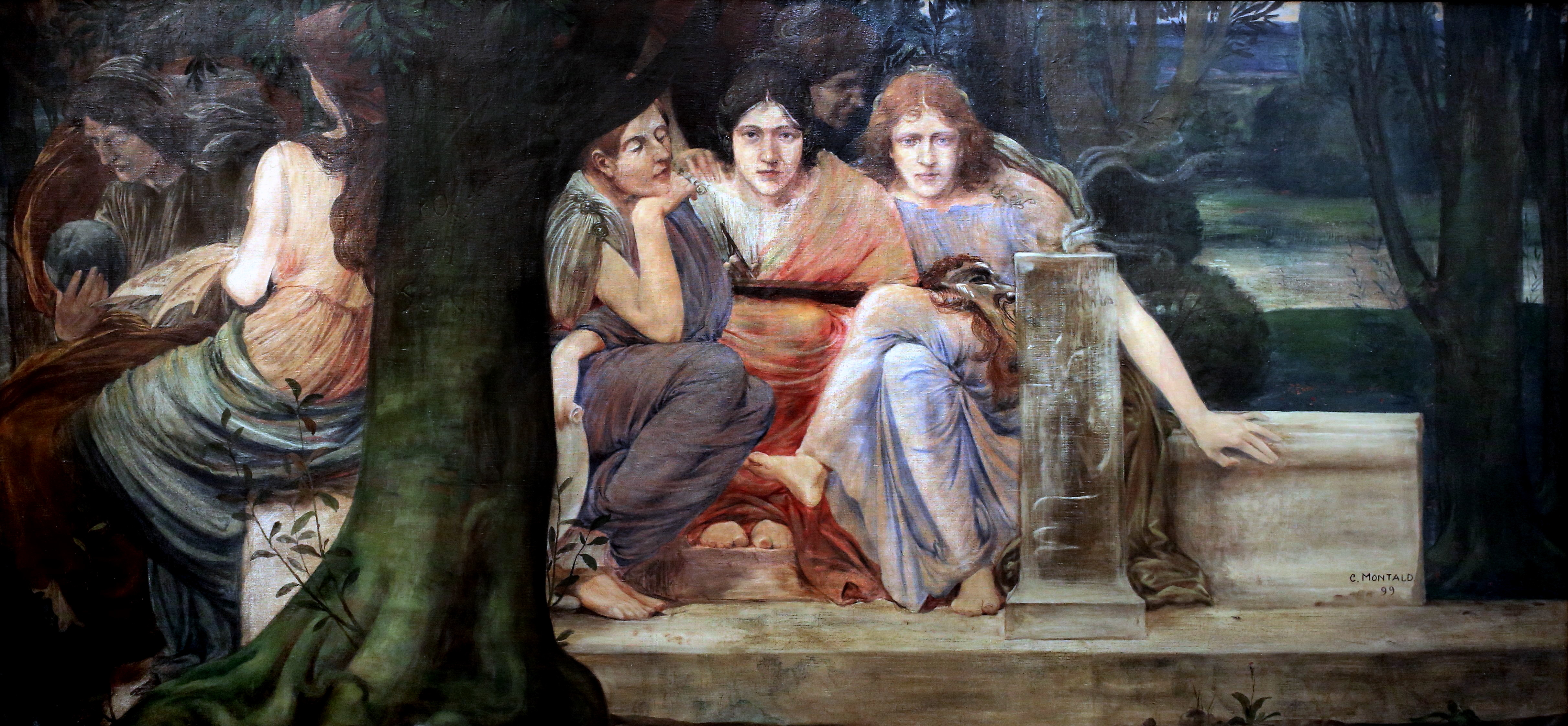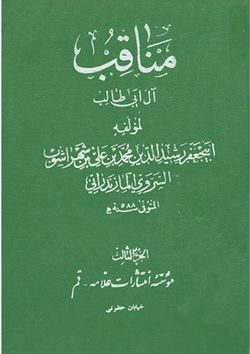|
Manāqib
''Manāqib'' (Arabic مَناقِب, also transliterated ''manāḳib''; singular مَنْقَبَ, ''manqaba/manḳaba'') is a genre in Arabic, Turkish, and Persian literature, broadly encompassing "biographical works of a laudatory nature", "in which the merits, virtues and remarkable deeds of the individual concerned are given prominence" and particularly hagiographies (biographies of holy people). The principal goal of such works "is to offer to the reader a moral portrait and information on the noble actions of the individuals who constitute their subject or on the superior merits of a certain group".Ch. Pellat, “Manāḳib”, in ''Encyclopaedia of Islam'', ed. by P. Bearman, Th. Bianquis, C.E. Bosworth, E. van Donzel, and W.P. Heinrichs, 2nd edn, 12 vols (Leiden: Brill, 1960–2005), . Such texts are valuable sources for the socio-political and religious history of early and medieval Islam.Asma Afsaruddin, 'Excellences Literature', in ''Medieval Islamic Civilization: An En ... [...More Info...] [...Related Items...] OR: [Wikipedia] [Google] [Baidu] |
Hagiography
A hagiography (; ) is a biography of a saint or an ecclesiastical leader, as well as, by extension, an adulatory and idealized biography of a preacher, priest, founder, saint, monk, nun or icon in any of the world's religions. Early Christian hagiographies might consist of a biography or ' (from Latin ''vita'', life, which begins the title of most medieval biographies), a description of the saint's deeds or miracles, an account of the saint's martyrdom (called a ), or be a combination of these. Christian hagiographies focus on the lives, and notably the miracles, ascribed to men and women canonized by the Roman Catholic church, the Eastern Orthodox Church, the Oriental Orthodox churches, and the Church of the East. Other religious traditions such as Buddhism, Hinduism, Taoism, Islam, Sikhism and Jainism also create and maintain hagiographical texts (such as the Sikh Janamsakhis) concerning saints, gurus and other individuals believed to be imbued with sacred power. However ... [...More Info...] [...Related Items...] OR: [Wikipedia] [Google] [Baidu] |
Literary Genre
A literary genre is a category of literature. Genres may be determined by List of narrative techniques, literary technique, Tone (literature), tone, Media (communication), content, or length (especially for fiction). They generally move from more abstract, encompassing classes, which are then further sub-divided into more concrete distinctions. The distinctions between genres and categories are flexible and loosely defined, and even the rules designating genres change over time and are fairly unstable. Genres can all be in the form of prose or poetry. Additionally, a genre such as satire, allegory or pastoral might appear in any of the above, not only as a subgenre (see below), but as a mixture of genres. They are defined by the general cultural movement of the historical period in which they were composed. History of genres Aristotle The concept of genre began in the works of Aristotle, who applied biological concepts to the classification of literary genres, or, as he ca ... [...More Info...] [...Related Items...] OR: [Wikipedia] [Google] [Baidu] |
Malik Ibn Anas
Malik ibn Anas (; –795) also known as Imam Malik was an Arab Islamic scholar and traditionalist who is the eponym of the Maliki school, one of the four schools of Islamic jurisprudence in Sunni Islam.Schacht, J., "Mālik b. Anas", in: ''Encyclopaedia of Islam, Second Edition'', Edited by: P. Bearman, Th. Bianquis, C.E. Bosworth, E. van Donzel, W.P. Heinrichs. Brill Online. Born in Medina into the clan of Humayr which belonged to the Banu Taym of Quraysh, Malik studied under Hisham ibn Urwa, Ibn Shihab al-Zuhri, Ja'far al-Sadiq, Nafi ibn Sarjis and others. He rose to become the premier scholar of hadith in his day, Referred to as the Imam of Medina by his contemporaries, his views in matters of jurisprudence became highly cherished both in his own life and afterward, becoming the eponym of the Maliki school, one of the four major schools of Islamic jurisprudence. His school became the normative rite for Sunni practice in much of North Africa, al-Andalus (until the ex ... [...More Info...] [...Related Items...] OR: [Wikipedia] [Google] [Baidu] |
Al Saqib Fi Al-Manâqib
''Al Saqib Fi al-Manâqib'' is a book on the miracles of Muhammad, other prophets, and Shiite imams. It has also been called Saqib Al Manaqib. The book was written by Ibn Hamzeh Tousi, also known as Emad al Din Tousi, an Imami jurist in the sixth year of Hijrah. Content The book has fifteen chapters. The first focuses on Muhammad's miracles, while following chapters look at Ali, Fatimah, and Hasan Ibn Ali's miracles. The text focuses only on miracles and wonderworks (Karamat), rather than the figures' biographies. Included miracles include speaking with animals, knowledge to Absent Things, and an instance when Hasan Ibn Ali Hasan ibn Ali (; 2 April 670) was an Alids, Alid political and religious leader. The eldest son of Ali and Fatima and a grandson of the Islamic prophet Muhammad, Hasan briefly ruled as Rashidun caliphate, Rashidun caliph from January 661 unt ... was able to change the sexuality of a man and a woman. Sources Some sections of the text draw from oth ... [...More Info...] [...Related Items...] OR: [Wikipedia] [Google] [Baidu] |
Manaqib Of Ale Abi Talib
Manaqib Ale Abi Talib ( ') is a book written by the Shi'a Muslim scholar Ibn Shahr Ashub. Author Abu Jafar Muhammad Ibn Ali Ibn Shahr Ashub or Ibn Shahraˆshuˆ b(489-588 lunar/1096-1192) was an Imami theologian and jurist of Mazandaran in Persia. He had the reputation of being the greatest Shiite scholar of his time and was highly thought of even by the Sunnis. he was known as Rashid Al din And Ezza Al-Din. He also wrote books such as Al Maalim. Subject The book is on virtues and characters of Muhammad, twelfth Imams, and companions of Muhammad. Motive The Author mentioned reasons for writing the book such as Challenge between Shia and Sunni on Imamate or leadership, distorted narrations by some narrators on the subject of Imamate of Ali. Authenticity The book is admired by Shia scholars and referred by them. Content Some of the contents of the book are as follow: * Section on Our Sayyed the apostle of Allah * Section on Imamate or leadership * Section on Grades of Ali * ... [...More Info...] [...Related Items...] OR: [Wikipedia] [Google] [Baidu] |
Sidi Mahrez
Sidi Mahrez ben Khalaf or Abu Mohamed Mahrez ben Khalaf ben Zayn (; 951–1022) was a Tunisian Wali, scholar of the Maliki school of jurisprudence and a Qadi. He is considered to be the patron-saint of the city of Tunis. Life He was born in Ariana to a father of Arab origin who traced his lineage to Abu Bakr. He studied in Kairouan and then in Fatimid-Egypt and became a teacher of Maliki jurisprudence upon his return. At the age of 57, he left his home-town (Ariana) and went into seclusion in Carthage. In c. 1014 he settled in Tunis, in a house in Bab Souika, which would become his mausoleum and later the Sidi Mahrez Mosque.« Sidi Mahrez, pour toujours », ''La Presse de Tunisie'', 17 septembre 2007 He proposed to his teacher |
Abu Yazid
Abū Yazīd Makhlad ibn Kaydād Dajjal (; – 19 August 947), was a member of the Ibadi sect. He opposed the Ismaili Shia rule of the Fatimids in North Africa and sought to restore Ibadi dominance in the region. Known as the Man on the Donkey () due to his humble means of transport, Abu Yazid led a rebellion against the Fatimid Caliphate in Ifriqiya (modern Tunisia and eastern Algeria) starting in 944, rallying various Berber tribes and disaffected groups against the Fatimids. His forces initially achieved significant victories, even threatening the Fatimid capital of Mahdia, al-Mahdiyya. Abu Yazid conquered Kairouan for a time, but was eventually driven back and defeated by the Fatimid caliph al-Mansur bi-Nasr Allah in 947, Abu Yazid escaped following a siege, but was wounded and captured. He died of his wounds several days later. Early life Abu Yazid's father Kaydad was a Zenata Berbers, Berber from Taqyus or Tozeur in the district of Chott el Djerid, then still known by ... [...More Info...] [...Related Items...] OR: [Wikipedia] [Google] [Baidu] |
Abu ʾl-Ḥasan ʿAlī Ibn Khalaf Al-Ḳābiṣī
Abu ʾl-Ḥasan ʿAlī ibn Muḥammad ibn Khalaf al-Maʿāfirī al-Qābiṣī (935–1012) was a leading Ifrīqiyan scholar ('' uṣūlī'') of the Mālikī school of Islamic jurisprudence (''fiḳh''). In 996, he succeeded his first cousin Ibn Abī Zayd as leader (''shaykh'') of the school in al-Qayrawān (Kairouan). Al-Qābiṣī's father was born in the village of al-Maʿāfiriyyīn near Qabis (Gabès) and his mother was from al-Qayrawān. According to oral tradition, he was the first cousin of Ibn Abī Zayd and Muḥriz ibn Khalaf, the sons of his mother's sisters. He was blind. In Africa al-Qābiṣī was taught by Abu ʾl-ʿAbbās al-Ibyānī, a Shāfiʿī scholar from Tunis; Darrās al-Fāsī, an Ashʿarī; and Ibn Masrūr al-Dabbāgh. Accompanied by Darrās al-Fāsī and the Andalusian al-Aṣīlī, he went on a lengthy '' riḥla'' (journey) in the east from 963 until 968. During his journey, because he was blind, his companions acted as his secretaries. Before he ... [...More Info...] [...Related Items...] OR: [Wikipedia] [Google] [Baidu] |
Sahnun
Sahnun ibn Said ibn Habib al-Tanukhi () (c. 776/77 – 854/55) (160 AH – 240 AH ) was a jurist in the Maliki school from Qayrawan in modern-day Tunisia. Biography His full name was Abu Said Abd al-Salam ibn Said ibn Habib ibn Hassan ibn Hilal ibn Bakkar ibn Rabia al-Tanukhi (). He gained the nickname Saḥnūn (a type of sharp bird) because of his quickness of mind. He was born to an Arab family that originated in Syria, his father was a soldier from Homs in present-day Syria. He was from the tribe of Tanukh. In his youth Sahnun studied under the scholars of Qayrawan and Tunis. In particular, he learned from the Tripolitanian scholar `Ali bin Ziyad, who had learned from Imam Malik. In 178 AH he traveled to Egypt to study under other pupils of Malik, who died before Sahnun had the financial means to reach them. Later on he continued to Medina Medina, officially al-Madinah al-Munawwarah (, ), also known as Taybah () and known in pre-Islamic times as Yathrib (), is ... [...More Info...] [...Related Items...] OR: [Wikipedia] [Google] [Baidu] |
Ibn Taymiyyah
Ibn Taymiyya (; 22 January 1263 – 26 September 1328)Ibn Taymiyya, Taqi al-Din Ahmad, The Oxford Dictionary of Islam. http://www.oxfordreference.com/view/10.1093/acref/9780195125580.001.0001/acref-9780195125580-e-959 was a Sunni Muslim ulama, scholar, faqīh, jurist, muhaddith, traditionist, Sufism, Sufi, Qadiri, history of Islam#Proto-Salafism, proto-Salafi aqidah, theologian and aniconism in Islam, iconoclast.Nettler, R. and Kéchichian, J.A., 2009. Ibn Taymīyah, Taqī al-Dīn Aḥmad. The Oxford Encyclopedia of the Islamic World, 2, pp.502–4. He is known for his diplomatic involvement with the Ilkhanid ruler Ghazan Khan at the Battle of Marj al-Saffar (1303), Battle of Marj al-Saffar, which ended the Mongol invasions of the Levant. A legal jurist of the Hanbali school, Ibn Taymiyya's condemnation of numerous Sufism, Sufi practices associated with wali, saint veneration and ziyarat, visitation of tombs made him a controversial figure with many rulers and scholars of the tim ... [...More Info...] [...Related Items...] OR: [Wikipedia] [Google] [Baidu] |



